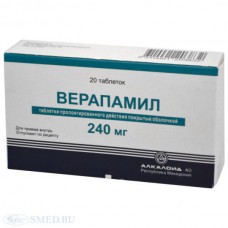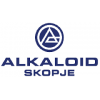Expiration date: 04/2026
Composition
1 tablet contains 240 mg verapamil
Packaging
20 PCs
Pharmacological action
Verapamil is a selective blocker of calcium channels of the first class. Main pharmacological properties of the drug due to its ability to inhibit the entrance of calcium ions in and cardiomiotita gladkomyshechne cells of the vascular wall through slow calcium channels of the membrane. Verapamil possesses antiarrhythmic, antianginal, and hypotensive activity. Reduces the need of myocardium in oxygen by reducing contractility of the myocardium and deceleration in heart rate. Causes dilation of the coronary arteries and increase coronary blood flow. The antihypertensive effect of Verapamil is associated with a reduction in tone of smooth muscles of peripheral arteries and with the ability to reduce CSO. Slowing AV conduction, Verapamil exerts antiarrhythmic action in supraventricular arrhythmia, normal heart rate remains unchanged or decreases slightly.
Verapamil also has a natriuretic and diuretic effect by reducing tubular reabsorption.
Testimony
- preventing strokes (including strokes Prinzmetala),
- treatment and prevention of supraventricular arrhythmias (paroxysmal supraventricular tachycardia, atrial fibrillation, atrial flutter, extrasystoles),
- hypertension.
Contraindications
- cardiogenny shock
- bradycardia,
- syndrome of weakness of sinus node,
- AV blockade II-III degree,
- syndrome Wolff-Parkinson-white,
- hypotension,
- chronic heart failure II B - III stage, acute heart failure,
- hypersensitivity to the drug.
Method of application and doses
The dosage regimen of Verapamil hydrochloride is determined individually. Adults administered in an initial dose of 40-80 mg 3 times per day. The maximum daily dose was 480 mg. Children 6-14 years of age shall, 80-360 mg / day, children up to 6 years - 40-60 mg per day, frequency of use 3-4 times a day. The tablets are taken during meals or immediately after eating, squeezed small amounts of water.
Side effects
From the side of cardiovascular system: bradycardia (less 50 beats/min), expressed lower AD, the development or worsening of heart failure, tachycardia, rarely - angina pectoris, until development myocardial infarction (especially in patients with severe obstructive coronary artery disease), arrhythmias (including atrial fibrillation and ventricular), with the rapid on/in the introduction - AV blockade III extent, asystole, collapse.
CNS and peripheral nervous system: dizziness, headache, fainting, anxiety, confusion, fatigue, asthenia, drowsiness, depression, ekstrapiramidnye violations (ataxia, mask-like face, shuffling gait, stiffness of the hands or feet, trembling hands and fingers, difficulty swallowing).
From the digestive system: nausea, constipation (rare - diarrhea), giperplazia gums (bleeding, soreness, puffiness), increased appetite, increase in liver transaminases and alkaline phosphatase.
Allergic reactions: skin itching, skin rash, skin hyperemia, exudative erythema multiforme (including Stevens-Johnson syndrome).
Other: increased body mass index, very rarely - agranulocytosis, gynecomastia, hyperprolactinemia, galactorrhea, arthritis, transient vision loss amid Cmax, pulmonary edema, asymptomatic thrombocytopenia, peripheral edema.
Special instructions
Be wary appoint drug patients with impaired liver function after acute myocardial infarction. The use of Verapamil during pregnancy is possible only in the case when expected benefit for mother exceeds the potential risk to the fetus. When use of the drug during lactation should decide the issue of termination of breastfeeding.
Be wary appoint Verapamil patients, engaged in potentially hazardous activities, require increased attention and rapid motor and mental reactions.
Drug interactions
Concurrent use of Verapamil and beta-blockers, antiarrhythmic drugs, inhalation anesthesia can lead to mutual strengthening cardiodepressivne effects (AV blockade, bradycardia, hypotension, heart failure). With simultaneous use with quinidine in patients with hypertrophic obstructive cardiomyopathy may develop severe hypotension and pulmonary edema.
When concomitant administration of Verapamil with other antihypertensive drugs observed mutual potentiation of their effects. Verapamil is able to significantly increase the concentration of digoxin in plasma, which requires dose reduction of the cardiac glycoside when administered together. Neurotoxic action of Verapamil potentiated with carbamazepine and lithium salts, and the psychotropic effects of lithium when administered together with verapamil attenuated. The concentration of cyclosporine or theophylline in plasma when administered together with Verapamil increased. Rifampicin, phenytoin, phenobarbital, and cimetidine can reduce the concentration of Verapamil in plasma and reduce the effectiveness of the latter. Verapamil potentiates the action of muscle relaxants.
Storage conditions
Keep at temperature not exceeding 25°C.


